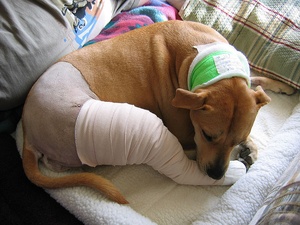Cranial cruciate ligaments in dogs perform the same task as the anterior cruciate ligament, or ACL, in humans. They both act as important stabilizers inside the knee and both can be damaged during exercise. In dogs, the ligament and related damage can be more complex than in humans, resulting in varying degrees of lameness and tearing.
While at the Purina Sporting Dog Summit, Dr. James L. Cook, DVM, PhD, DACVS, DACVSMR, discussed several topics, one of which was the importance of warming your dog up prior to exercise and competition.
“Never take a dog straight from a crate to the performance realm,” said Cook, referring equally to the conformation ring, agility course, hunt-test or field-trial line, etc. “If you’re going straight from the crate to performance, you’re an idiot.”
Now, that might sound harsh to those of us who pull our dog out of the box and get in line for competition, but the truth is: he’s right. Would an elite human athlete get out of bed and immediately strap on the skis, run a marathon or get on the court of competition without so much as stretching? Would you get off the couch and undergo physical exercise ...









